The Internal Revenue Service has started holding discussions with advocacy groups on the free direct file tax system it plans to begin testing early next year.
Earlier this month, the IRS said it had developed a prototype of such a system as part of a study it conducted in accordance with the Inflation Reduction Act (see story). The study found a 72% majority of taxpayers said they are either very interested or somewhat interested in using an IRS-provided tool to prepare and file their taxes.
To supplement the survey, the service enlisted the support of the U.S. Digital Service, a technology consulting agency that works with the White House, to build a functioning internal prototype of a multilingual “mobile-friendly” tax filing tool.
Last week, the Treasury Department’s chief implementation officer for the IRA, Laurel Blatchford, and IRS acting chief transformation officer Bridget Roberts held a roundtable discussion with civil rights and advocacy organizations to discuss the need to make tax filing easier and less expensive for taxpayers, especially in underserved communities.
During the conversation, Treasury and IRS officials discussed taxpayer support for a free online filing option and the development of a pilot program for a direct file option during the 2024 filing season.
Under the vision detailed in the IRS Strategic Operating Plan, taxpayers would be able to seamlessly interact with the IRS in ways that work best for them, whether it’s on the phone, in person or online. By pilot-testing a free option to file taxes online directly with the agency, the Treasury and the IRS hope to be able to gather new information to improve and develop their customer service tools.
It’s unclear how those plans would be affected by the funding cut to the IRS that’s being included as part of the debt limit deal announced over the weekend by President Biden and Speaker of the House Kevin McCarthy, R-California. The deal would take approximately $20 billion out of the $80 billion allocated to the IRS over 10 years under the IRA and distribute it to other parts of the federal government.
For part of the study on the feasibility of the direct file system, the IRS enlisted the help of the Washington, D.C., think tank New America.
“I’m not in a place to be able to comment on those cuts, and on how they’ll be spread across various parts of the IRS, but I can say that one of the key things we found in our report and our work was the importance of sustained funding and long leadership for the feasibility of a future direct file system,” said Ayushi Roy, deputy director of New America’s New Practice Lab and co-author of the IRS Direct File Third-Party Report. “That funding for the resourcing and the customer support will be really important for future feasibility.”
After analyzing the IRS’s part of the report, as well as interviewing 72 experts, and reviewing reports and data from surveys, the third party review by New America and and Ariel Jurow Kleiman, an associate professor of law at Loyola Law School in Los Angeles, concluded that the feasibility of a direct file product depends on the IRS’s ability to maintain the initiative as a leadership priority, starting with limited scope, expanding over time, and addressing each of the imperatives highlighted at each stage of design and implementation.
“The IRS portion of the feasibility study was more focused on cost and taxpayer experience,” said Roy. “One of the ways that they gauge taxpayer experience was by using effectively a very lightweight prototype — call it a ‘wireframe’ — where they showed what a future set of questions might look like in a system and had a very limited set of constituents provide that survey response.”
The IRS part of the report found that developing a direct file system would require the agency to develop new skills and processes to operate, maintain and improve complex technological products, and to provide customer support.
50 different hurdles, and the earlier Free File
One of the challenges would be integrating the IRS’s direct file system with those of other states, including state governments controlled by both Republicans and Democrats.
“Some states are actually pretty far ahead of the IRS in creating their own direct file systems,” said Roy. “There are 14 states around the country that already have their own direct file system. It’s very much not limited to more left-of-center states or anything like that. Kansas and Alabama, among other states, have their own direct file system ahead of the IRS. I don’t know that cooperation will be the challenge. It’s more about the data interoperability that will be key.”
States sometimes develop their own direct file software or leverage tax software developed by outside companies.
“The state will sometimes use off-the-shelf software that they will customize and then run by the state department of revenue itself, or the comptroller’s office, and in other cases, the state will build their own software in-house, but either way it’s a state-run operation,” said Roy. “Like the federal direct file, it provides a free option for taxpayers of that state to be able to file their returns.”
The IRS has long offered a Free File program featuring an array of third-party software from outside vendors who are part of the Free File Alliance. This year, the Free File Alliance included a number of commercial tax software providers, such as TaxAct, TaxSlayer, FreeTaxUSA, 1040Now, OLT and FileYourTaxes.com, offering various forms of tax prep to taxpayers who earn less than $73,000 in adjusted gross income, but there are often extra charges for state tax software.
The two biggest tax software providers, Intuit’s TurboTax and H&R Block, no longer participate in the Free File program but they continue to offer free editions, although many taxpayers end up paying extra for more complex returns and state tax software. Cash App Taxes also offers free tax prep, but it too isn’t part of the IRS’s Free File program. The IRS already offers a Free File Fillable Forms option in conjunction with its Free File program.
The IRS may decide to build off of the Free File Fillable Forms option, although it has limited features, functioning mostly like a PDF with some computational capabilities, but without the interactive interview format used by many consumer tax prep programs.
During a press conference this month, Jurow Kleiman outlined some of the various filing options the IRS has offered over the years: “There was telefile, spanning a certain number of years from the 1990s to the early 2000s, where people could call the IRS and provide their income information and household information, and then the IRS would compute the taxes that they owed. That was similar to an online system, but done over the telephone. And it also used to be that people could go in person to a Taxpayer Assistance Center and have their returns prepared up until 2014. Then, of course, today, there’s the VITA program, Volunteer Income Tax Assistance and Tax Counseling for the Elderly, which provides in-person tax preparation services done by volunteers, but entirely overseen by the IRS. There are a lot of different versions of tax preparation assistance, all the way up to free fillable forms.”
The Free File Fillable Forms software was developed by an outside company for the IRS.
“One of the major differences for the Free Fillable Forms is they’re developed by one of the Free File Alliance members,” said David Koh, a software engineer and member of the IRS Direct File Third-Party Task Force, a former director of engineering at OkCupid, and co-founder of the government technology consulting company Slip Stitch, during the press conference. “It’s essentially similar to the other Free File privately developed products that the IRS offers, notably to everyone, regardless of the restrictions with the rest of the Free File program. But it’s very much designed to sort of mirror what it’s like to do a PDF form. The user experience is essentially very similar to filling out your taxes on paper. The major technical challenge with developing the direct file system is to create a better experience for tax filing, which is a fundamentally different goal and a fundamentally different challenge. I would say that there’s unlikely to be a lot of things leveraged from the technical aspect of free fillable forms.”
The IRS is still relying on some antiquated systems that date back decades, in some cases to the 1960s, and would need to make its direct file work with those. Other issues include data security and privacy, identity protection, and interoperability challenges between the agency’s Modernized eFile system and its other systems, and the future direct file system. The IRS has experienced identity theft problems and data breaches in the past with systems like its Get Transcript and Identity Protection PIN programs (see story).
“These are all really big, meaty challenges that the IRS will need to address in order to ensure visibility,” said Roy. “I will just say, though, that as a technologist who’s built many systems for federal governments, the age of the system is not an automatic problem. The issue is when the aged system is not mindful of the user experience. As long as an older system is still able to be updated in a way that is providing a user-friendly or easy-to-use experience for constituents, that’s perfectly fine. Age alone is not necessarily an indicator of success, or lack thereof, just from a technology standpoint.”
The IRS is likely to build the direct file system as an extension of its current array of systems.
“My understanding is that direct file would definitely need to build upon existing systems, including MeF, and the Free File Fillable Forms,” said Roy. “MeF does a really phenomenal job at the moment processing 160 million [returns]. Every single federal electronically filed return goes through the MeF system, so a future direct file system would definitely plug into that as well as some of the Free Fillable Form options. The main difference is that Free Fillable Forms at the moment is not necessarily the most easy-to-use or user-friendly experience, so a future direct file system would hopefully be updating that ease of use.”
Credit: Source link











